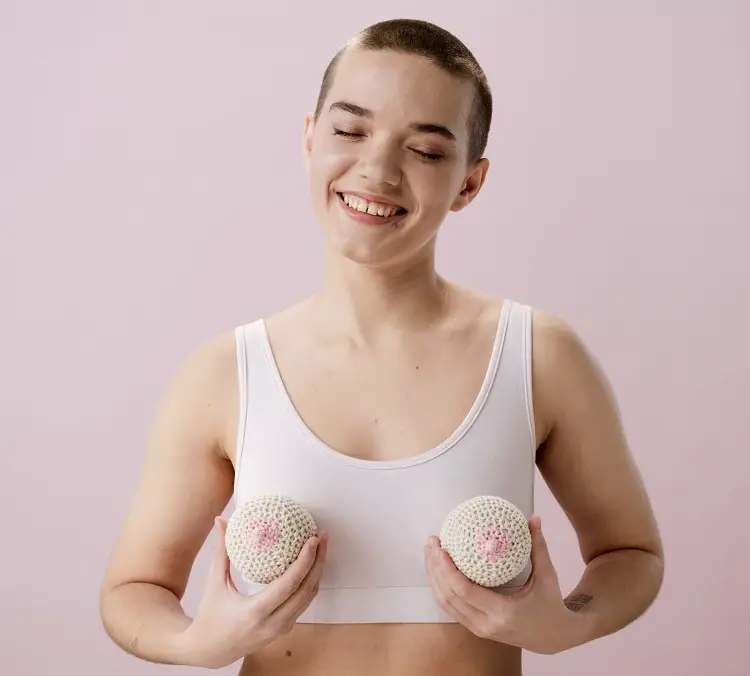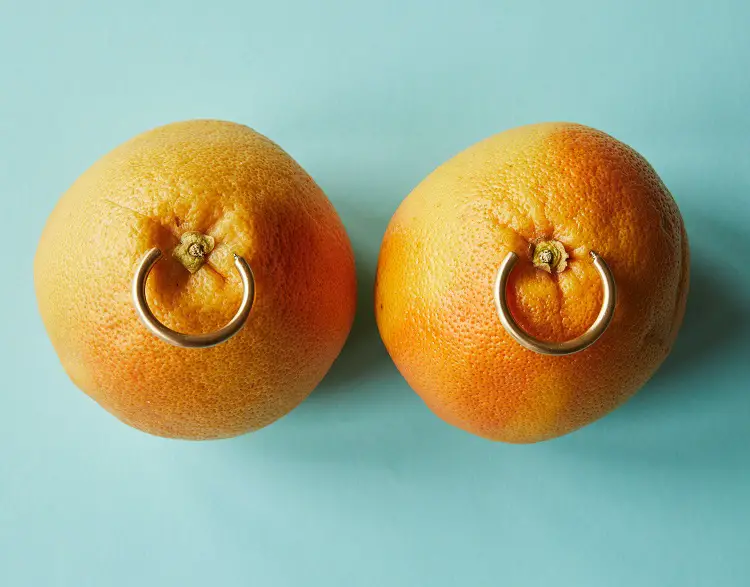Are you wondering how to increase nipple size for feeding? Well, naturally nipples come in all kinds of shapes and sizes and not all nipples point out away from the breast. Some women’s nipples are flat while others are inverted and pull into the breast or somewhere in between.
As you should know, several factors can affect the size and shape of the nipple which include the amount of fat in your breast, the length of your milk ducts, and the density of connective tissue under your nipples.
During pregnancy, the shape of your nipples may also change. A lot of moms with inverted, flat, or pierced nipples have no issues with breastfeeding, while others need extra support.
Don’t panic if your nipples are flat or inverted, it’s practically possible to breastfeed your baby with them. Here, we share some helpful tips to make breastfeeding a little easier.
So whether your nipples are flat or inverted don’t give up, with a little patience and extra time breastfeeding with flat nipples will become a reality.
How To Tell If You Have Flat Or Inverted Nipples?
Usually, flat nipples don’t protrude away from the areola which is known as the dark region surrounding the nipple, even when stimulated.
An inverted nipple goes inwards like a dimple at the center even when stimulated. Sometimes inverted nipples retract back so they are on the same level as the areola, or they may even sink into the breast tissue.
Naturally, one or both nipples can be affected, and a report has shown that up to 10% of first-time moms have at least one inverted nipple.
If you’re a first-time mom and you’re unsure whether your nipple is inverted, try practicing the ‘pinch test’ by simply compressing your breast gently, with your thumb and forefinger on either side of the areola.
Normally, the nipples are supposed to poke out, but if yours retracts or pulls inwards, creating a hollow at the end, then it’s likely to be inverted.
Read Also: How To Stimulate Nipple To Induce Labor
How To Increase Nipple Size For Feeding: 10 Practical Tips

You may notice that during pregnancy your breasts change, your nipples begin to protrude more by themselves. If not, and you’re worried that their shape could make the breastfeeding experience difficult; here are 10 tips to keep in mind to make breastfeeding with flat nipples easier.
1. Wear Nipple Formers
Nipple formers are a soft, flexible silicone disc that fits discreetly inside your bra and places gentle pressure on your nipples, helping draw them out.
According to Sioned, this product can be worn from week 32 of a normal pregnancy. Just begin with just an hour a day and build up to around 8 hours.
If you have a weakened cervix or if you’re at risk of delivering pre-term, talk to your doctor about when to start using them, since nipple stimulation can bring on contractions.
Sioned also suggested, “Moms can continue to wear the nipple formers once their baby is born” Try popping them inside your bra between 30 to 60 minutes before breastfeeding your baby.
2. Nipple Shield
This is simply a thin, flexible piece of silicone, in a nipple-shaped form, with holes in the tip for a smooth passage of breast milk.
One of the unique benefits of the nipple shield is that it offers your baby a larger, firmer target, as well as stimulating her palate to encourage him to suck.
Generally, nipple shields are often considered as a short-term solution. If problems or pain persists, consult your doctor or lactation consultant, whose job is to make sure that your baby is latching well with the shield in place.
If you live in the United States, you should be able to find an international board-certified lactation consultant online on the (USLCA) United States Lactation Consultant Association website.
However, if residing outside of the United States, try consulting the International Lactation Consultant Association. Additionally, always watch your baby’s weight gain to make sure that your milk supply is building to meet his needs.
As time goes on, as your baby’s suck gets stronger and your nipples become more used to breastfeeding, you might be able to breastfeed without the nipple shields. This product can also be used to protect sore nipples.
Read Also: How To Relieve Sore Nipple Breastfeeding
3. Hand Express
When your breast is much engorged with milk, it may feel hard and your nipple may become flattened. By hand-expressing, a bit of milk your breast becomes soften which can help your baby latch on more easily. Simply follow these steps
- Cup your breast with one of your hands, while you use the other hand to make a “C” shape with your thumb and forefinger near the areola, but not on it.
- Now gently squeeze and release the pressure.
- Repeat this step and try to get a flow going without sliding your fingers over the skin.
- You’ll see some drops of liquid just before your milk begins to flow.
- Try to hand express enough to soften your breast.
4. Pull Back
Pulling back on your breast tissue can make breastfeeding with flat nipples or inverted nipples easier even if your nipple doesn’t stick out completely.
Doing this can help your baby get a better latch. To do this effectively, simply hold the breast tissue behind the areola and gently pulling back towards your chest.
5. Use a Breast Pump
Another effective tip is to use the suction from a breast pump to draw out a flat or inverted nipple if other methods stimulate your nipples to fail. This method can be very effective if your nipples are deeply inverted.
There are a lot of breast pumps available in the market, which include both manual and electric breast pumps. Here are some of the best and yet affordable breast pumps you can buy online. You can also be able to get a breast pump through your health insurance.
Usually, health insurance providers would want you to buy the pump through a specific vendor. Choices are often restricted but often include popular brands. Contact your health insurance to provide you with more information.
6. Hold Your Breast
Holding your breast while nursing can make your baby breastfeed easier and latch on properly. Here are two practical ways to try.
C-hold:
This method helps you control your breast movement so that you can easily guide your nipple toward your baby’s mouth. The C-hold is also known to flatten your breast for a better fit in your baby’s mouth. To do this simply
- Using your hand make a “C” shape.
- Place both hands around your breasts ensuring that your thumb is on top of your breast and your fingers are on the bottom.
- Ensure that your thumb and fingers are behind the areola.
- Now use your fingers and thumb to squeeze gently, pressing your breast like a sandwich.
V-hold:
This method uses both your forefinger and middle finger to create a scissor-like shape around your areola and nipple. To do this simply
- Place your nipple in between your forefinger and middle finger.
- Now, ensure that both your thumb and forefinger are on top of your breast while the remaining fingers are underneath the breast.
- Gently press down towards your chest to help squeeze out the nipple and areola.
Read Also: 12 Interesting Facts About The Nipple You May Not Know
7. Other Suction Devices
There are a lot of suction devices that work effectively in drawing out inverted nipples. These products are sold online under different names, and this includes nipple extractors or nipple retractors.
You can also wear these products under your clothing and they work effectively by pulling your nipple into a tiny cup. In the long run, they can help loosen nipple tissue. You can buy all kinds of suction devices here.
8. Stimulate the Nipple
You can effectively coax your nipple out by gently stimulating the nipple yourself by gently rolling your nipple between your thumb and finger with a cold, damp cloth.
You can also practice the Hoffman technique, which was introduced by Dr. J Brooks Hoffman. This technique was created to help women breastfeed with flat or inverted nipples.
A 2017 study was found that this technique effectively improved the nipple type and the quality of breastfeeding. To practice this technique, follow these steps
- Keep both your index and thumb on either side of your nipple.
- Press your fingers gently into the breast tissue.
- Now stretch the areola gently in each direction.
- Repeat these steps five times each morning if you can without pain.
Alternatively, you can practice the exercise with both hands, using both of your thumbs.
9. Check the Diaper
This is another effective way to ensure that your baby is getting enough breast milk. Your baby should always have wet and dirty diapers.
By the period your milk comes in, your baby should have about six or more wet diapers each day and should poop three or more each day.
Read Also: How Long Can A Breastfeeding Baby Go Without Pooping?
10. Surgical Options
If all the above natural methods mentioned fail to work, surgery may be an option. Usually, there are two types of surgery for fixing inverted nipples. One type preserves some of the milk ducts so that you can still be able to breastfeed while the other does not. Consult your doctor for the best possible approach that is suitable for you.
Can I Breastfeed With Pierced Nipples?

A lot of women with pierced nipples suggested that it has no impact on their ability to breastfeed – although it is advised to remove jewelry before feeds as it can cause a choking hazard and could graze your baby’s tongue, gums, or palate.
According to Kellie a mom of three in the UK she said “I had a nipple piercing, but removed it a year later when I got pregnant as my breasts felt sensitive,” She also added “I was able to breastfeed my daughter exclusively, and then her two younger brothers, without any problems whatsoever. If anything, the pierced nipple was the favorite!” She says.
However, some moms find their breast milk leaking from their piercing holes, or suspect scarring from the piercing which reduces their milk supply for their baby.
Since there hasn’t been enough research in this area; Sioned stated that it will be difficult to know how a piercing will affect breastfeeding until your milk comes in.
It’s best advised to get help from a doctor or lactation consultant if you’re worried about it, bearing in mind that your baby can still get all the nutrition he or she needs from just one breast if there’s an issue with the other.
Related Posts:
- When To Switch Nipple Size For Baby
- How To Increase Breast Size with Food
- Do Mothers Get Turned On By Breastfeeding
- How To Get Rid Of Pregnancy Line on the Stomach (6 Natural Ways)
- 11 Newborn Night Feeding Tips To Help You Cope
Wind Up
We hope this article has given an in-depth discussion to answer the question, How to increase nipple size for feeding. As you should know, breastfeeding with flat nipples is possible, though for some women this can very difficult.
However, having the right information and trying out some of the tips we’ve mentioned can help make your breastfeeding experience a little bit easier for both you and your baby.
Do not forget to talk with your doctor about surgical options or consult a lactation consultation that can provide you with in-depth strategies for breastfeeding if you have concerns.
